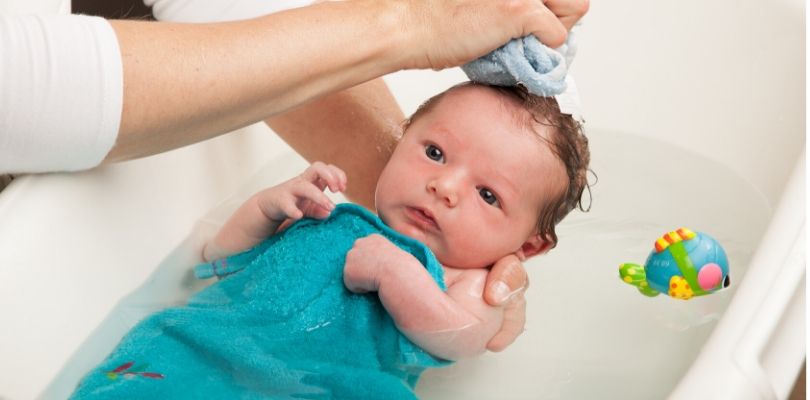How to Bathe a Newborn
Caring for your baby’s skin is an important role for parents. If you are a first-time parent, you might be having mixed feelings of joy, excitement and a little anxiety as you go home with your newborn baby. After breastfeeding, newborn skin care is the next most important step in ensuring your baby’s health. This article will tackle the basics for how to bathe a newborn.
The Difference Between Newborn Skin and Adult Skin
Healthy, full-term babies already have competent and functioning skin by the time they are out of the womb and their skin is continuously developing during the first 12 months of life. But compared to an adult, newborn skin is about 20% to 30% thinner.
As we all know, the skin is the largest organ in our body and its functions include serving as protective barrier for our internal organs, maintaining hydration and body temperature, producing hormones, to name a few.
Since newborn skin is thinner and has little to none of the normal bacteria on the surface to provide additional immunity, they are still vulnerable to a lot of external irritants. This is the reason why skin care is an important part of a newborn’s health and wellness.
When to Start Bathing Your Baby
If you have had a hospital-assisted birth, a full-term healthy baby is usually bathed immediately or two hours after birth if the baby’s body temperature is stable. This is done by a trained pediatric nurse or attendant with the purpose of removing the remaining mother’s blood, amniotic fluid and other debris from giving birth. This helps to remove any potential sources of infection to the baby.
After birth, the baby would normally be covered with a greasy, white, but harmless substance called vernix caseosa. It serves as additional protection for the baby while inside the womb and it has been observed to also add protection even outside the womb by preventing water loss and maintaining normal body temperature.
Therefore, doctors will recommend not to immediately wash off the vernix and the next bath is usually delayed on an average of 12 to 48 hours. Other benefits of delaying the bath would be prevention of hypothermia (low body temperature), promoting breastfeeding and allowing the mother to recover physically after birth before tending to the newborn.
How to Go About Bathing a Newborn
Appropriate cleansing of the baby’s skin is needed not only to prevent infection but for cleanliness and satisfaction of both the baby and parents. The most common practice of bathing newborns around the world involves sponge bathing and tub bathing.
Whichever method you choose is good. It is based off preference and it depends on the cultural practice of the parents. Newer studies have shown that tub bathing with lukewarm water (temperature of 37C) has a lesser risk for causing hypothermia and is generally more pleasurable to both mother and baby compared to sponge bathing.
Vaccines for babies help to protect your child from disease, such as hepatitis B. Here is what you need to know about when to vaccinate your baby.
The proper way of bathing your baby is outlined as follows:
- The bath should only last five to 10 minutes, using lukewarm and clean water in a small shallow tub.
- Cleansing agents like mild non-perfumed soap, oils, or alcohol should not be added to the water. The cleansing agent should only be used on the areas where it is needed, like in the armpits or buttocks where an oily residue or dirt cannot be removed by water alone.
- Bathing is recommended only twice or thrice a week. A warm cloth can keep the baby clean in between.
- Ensure that you have all your supplies within reach. Never ever leave the baby in the bath unattended. It is important to hold your baby securely.
- Remove any jewelry that may scratch the baby. Keep your nails clean and short.
- Wash the face and hands thoroughly, as these have the most exposure to dirt. Clean and wash the baby’s genitals and buttocks every diaper change to prevent irritation and diaper rash.
- If your baby’s a girl, wash her genitals from front to back without parting the vaginal lips. If your baby is a boy, do not retract the foreskin and keep the genitals clean using water.
- Use baby shampoo or mild soap to remove crusts and dirt from the baby’s scalp, but do not leave it for long to avoid irritation.
- Wash the umbilical cord gently with water. Do not pull on it or forcibly remove it, as it will fall off on its own within one to two weeks. Do not apply any topical agents like iodine or alcohol on the umbilical stump. Fold it over the diaper to prevent it from rubbing on the stump and keep it dry always.
- Do not use cotton swabs or cotton balls to clean your baby’s nose and ears. Just gently wipe using a towel.
- Pat and dry the baby thoroughly with a clean towel, then use another dry blanket to wrap and keep warm immediately after bathing.
What Products to Use
As the skin of a newborn is delicate, it is recommended that parents or caregivers use liquid, pH-neutral or mildly acidic cleansers (pH of 5.5 to 7.0) that are preservative free, or with preservatives that have demonstrated safely.
Ideally, a baby soap or cleanser should be fragrance and color-free to avoid irritation and eye stinging. It should also be able to remove dirt, sebum, saliva, urine, fecal matter easily. Giving this property to cleansing agents are what we call as surfactants. These are agents that attract both oil and water. These make the removal of dirt easier without requiring excessive friction or mechanical force during bathing. Examples of surfactants that you may see on the containers are sodium lauryl sulfate (SLS) or sodium laureth sulfate (SLES).
Syndets or synthetic detergents are substitutes for soap. They have a pH that is closer to normal skin and are less irritating and milder than soaps. They do not alter the pH of the skin and the skin bacteria remains unaltered, but they can cause dryness if they have no added moisturizers. Cocoyl isethionate, sodium lauryl sulphate and betaines are examples of commonly used syndets.
It is generally not recommended to use alkaline and bar soaps as these disrupt the normal pH of the baby’s skin, which might lead to irritation and other skin problems.







